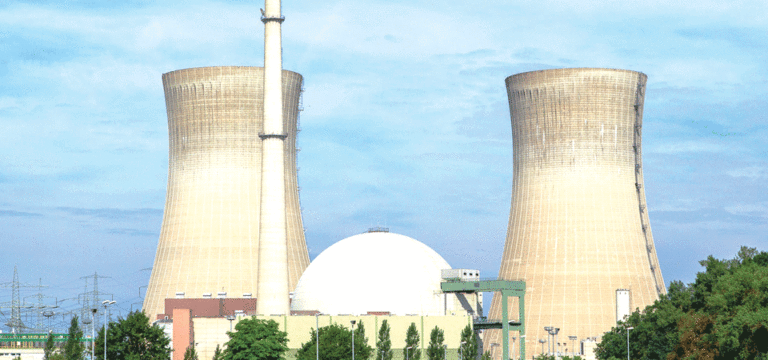
Rastradhoj Karki
Uranium was discovered in 1789 by German scientist Martin Heinrich Klaproth in the mineral pitchblende. It was isolated shortly after, but its radioactive properties were not recognized until 1896 by Henri Becquerel.
On a scale arranged according to the increasing mass of their nuclei, uranium is among the heaviest of all the naturally occurring elements (hydrogen is the lightest). Uranium is 18.7 times as dense as water.
Like other elements, uranium occurs in several slightly differing forms known as isotopes. These isotopes differ from each other in the number of uncharged particles (neutrons) in the nucleus. Natural uranium, found within the Earth’s crust. It has a mixture of mainly two isotopes: uranium-238 (U-238), accounting for 99.3%, and uranium-235 (U-235) is about 0.7%.
The isotope U-235 is important because certain conditions can make it readily split to yield a lot of energy. It is therefore said to be ‘fissile’; hence, we use the expression nuclear fission.
Meanwhile, like all radioactive isotopes, they decay. U-238 decays slowly, having the same half-life about the age of the Earth (4500 million years), meaning that it is barely radioactive. Nevertheless, it generates 0.1 watts/ton as decay heat, enough to warm the Earth’s core. U-235 decays slightly faster.
Uranium Atom
The nucleus of the U-235 atom comprises 92 protons and 143 neutrons (92 + 143 = 235). When the nucleus of a U-235 atom capture moving neutrons, it splits in two (fissions) and energy in the form of heat amidst some additional neutrons released. If enough of these expelled neutrons cause the nuclei of other U-235 atoms to split, releasing further neutrons, a fission ‘chain reaction’ can be achieved. When this happens, many millions of times, a huge amount of heat generates from a relatively small amount of uranium.
It is this process, ‘burning’ uranium, which occurs in a nuclear reactor. The heat produces steam to create electricity. If there is a lack of hydroelectricity, nuclear energy should be kept in as an option.
Uranium: a radioactive, silvery metal, is an element because it provides us with nuclear fuel to generate electricity in nuclear power stations. It is also a primary material from which other synthetic transuranium elements form.
Inside Nuclear Reactors
Nuclear power stations and fossil-fueled power stations of similar capacity have many features in common. Both require heat to produce steam to drive turbines and generators. In a nuclear power station, however, the fission of uranium atoms replaces the burning of coal or gas. In a nuclear reactor, the uranium fuel is always in a controlled chain reaction. The heat generated by this fuel is applied to make steam which spins a turbine to drive a generator, producing electricity.
The rods absorb neutrons in a chain reaction, injected or removed to set the reactor at the required power level.
The fuel elements are kept in check by moderators that slow the speed of the emitted neutrons and thus enable the chain reaction to continue. Water, graphite, and heavy water function as moderators in different types of reactors.
Because of the kind of fuel used (the concentration of U-235), if there is a malfunction in a reactor, the uranium fuel may overheat and melt but, it cannot explode like a bomb.
A typical 1000-megawatt (MWe) reactor can provide enough electricity for a modern city of up to one million people.
Uranium Mining
Before mining for radioactive minerals, no practice involving radiation exposure carried unless it produces a net benefit to those exposed or to society generally. No harm should be caused to its citizens by radiation.
Over two-thirds of the world’s uranium production from mines is from Kazakhstan, Canada, and Australia.
An increasing amount of uranium, now over 50%, is produced by in situ leachings. Kazakhstan mined the largest share of uranium from mines (40% of world supply from mines), followed by Canada (13%) and Australia (12%).
Nepal lies in the central part of the 2500km long Himalayan belt. Almost 83% of Nepalese territory is mountainously situated between China in the north and India in the south. Nepal is very rich in vast natural resources such as minerals, water, forest, medicinal herbs, and varieties of agricultural products, and more.
A large deposit of uranium has been discovered in the Upper Mustang region of Nepal. Preliminary research suggests that the deposit is spread over an area 10 km long and 3 km wide could be of the highest grade. International Atomic Energy Agency has confirmed this. It has also been found in Tinbhangale, Chandi Khola, and Chiruwa Khola (Makwanpur); Buka Khola (Sindhuli); Mardar Khola and Panpa Khola (Chitwan); Jamari Gad, Bangabagar, Baggoth, and Gorang (Baitadi); and traces in a different section of Chamliya River (Darchula) and more.
Harmful Effects
Uranium miners stay exposed to radon gas, a radioactive material thought to cause lung cancer. Uranium miners are exposed to mining dust, thought to cause lung disease, and more. The National Institute for Occupational Safety and Health (NIOSH) made a study to find if uranium miners have an increased risk for lung cancer and other lung diseases.
Regardless of how uranium obtained from its ore, the extraction process creates radioactive wastes. If not managed properly, mining waste and mill tailings can contaminate the environment.
Generally, the highest potential radiation-related health risk for uranium mining or processing facility workers is lung cancer associated with inhaling uranium decay products (more specifically, radon decay products), as well as other cancer risks correlated with gamma radiation exposure on-site. Nuclear power plants release about the same amount of carbon dioxide emissions per unit of electricity as wind. But, refining ore releases greenhouse gases contributing to global warming.
Uranium mining facilities produce tailings, disposed of in near-surface impoundments close to the mine. These tailings pose serious environmental and health risks in the form of Randon emission, windblown dust dispersal, and leaching of contaminants such as heavy metals and arsenic into the water. All countries should preserve their natural ecosystem.
Source : THE RISING NEPAL,






